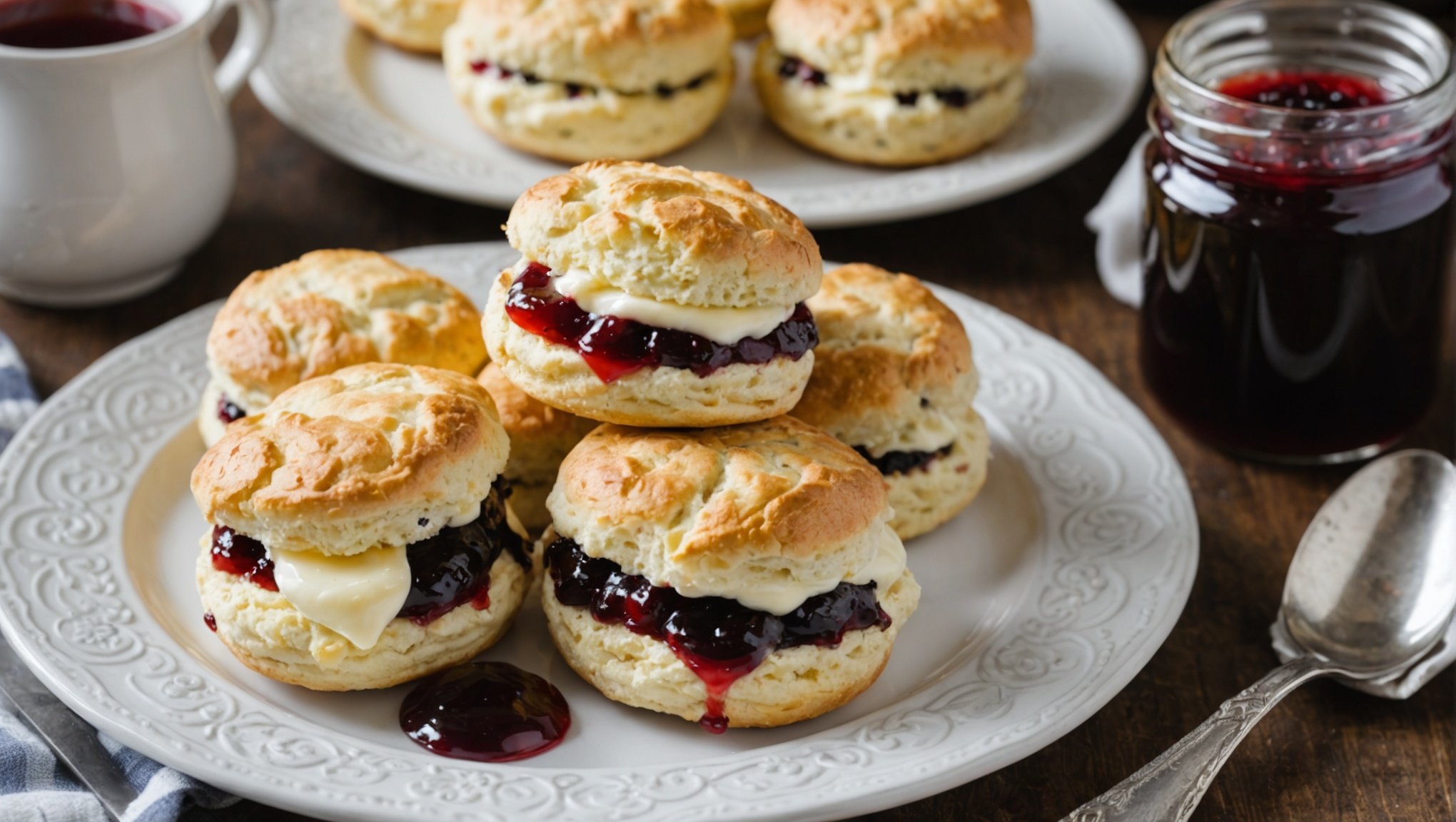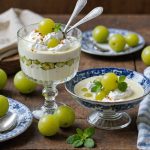Ingredients for Perfect Scones
Creating the quintessential English scone requires attention to detail, especially regarding its ingredients. Begin with all-purpose flour as the base, providing the scones with their characteristic texture. High-quality flour plays a vital role in achieving tender, crumbly results. Self-raising flour can be a worthy alternative for those seeking convenience.
For the richness and quintessential taste, use unsalted butter. Ensure it is cold and diced, contributing to the light and fluffy aspect of the scones. When rubbed into the flour, the cold butter forms pockets that help the dough rise perfectly.
Topic to read : A taste adventure: australian wine meets italian wine
The clotted cream and jam complete the classic English scone experience. Opt for freshly sourced clotted cream and a vibrant jam, such as strawberry or raspberry, for that authentic taste. These accompaniments elevate the scone’s richness, creating an indulgent treat.
For those with dietary restrictions, alternatives like gluten-free flour and dairy-free butter can be used without significantly sacrificing quality. Ensuring ingredient quality is paramount, as it directly influences the scone’s outcome. Sourcing locally, when possible, guarantees freshness and supports sustainability.
This might interest you : Unlocking the Secrets to a Succulent and Flavor-Packed Italian Porchetta with Fennel
Consider trialing different jams or experimenting with flavoured clotted cream for unique twists on traditional scones, catering to diverse tastes while maintaining classic elements.
Step-by-Step Preparation Guide
Perfecting scone preparation demands attention to detail, especially when it comes to mixing and kneading. Begin by sifting your dry ingredients, ensuring they’re light and free of lumps. This initial step is crucial for even raising, as it incorporates air into the mix.
When it comes to mixing, focus on integrating wet ingredients with a gentle hand. Over-mixing can activate gluten in the flour, leading to tougher scones. To achieve a crumbly, melt-in-your-mouth texture, aim for a mixture with chunks of butter resembling pea-sized crumbs before adding liquid. The key here is to blend just until the dough comes together.
For the right dough consistency, knead lightly on a floured surface. Limit to 5 to 7 folds before shaping, as excessive kneading can also compromise texture. The dough should be firm but not sticky – a delicate balance you’ll master with practice.
Chilling time is an often-overlooked but essential step. Resting the dough for at least 20 minutes in the refrigerator allows the butter to solidify, which helps in creating those sought-after flaky layers. Furthermore, chilled dough consistently retains its shape better during baking, ensuring uniform scones.
Incorporating these baking tips into your routine will enhance your mixing techniques, leading to consistently delicious scones.
Baking Techniques for Fluffy Scones
Preparing English scones with a perfectly light and airy texture requires a nuanced understanding of baking techniques. The first crucial factor is oven temperature. Ideally, setting the oven to 200-220°C (390-425°F) ensures an optimal environment for scones to rise and develop that signature soft and fluffy centre. This precise temperature means the exterior will bake quickly, sealing in moisture while preventing them from becoming dry.
When shaping scones, uniformity is vital for even baking. Using a well-floured surface and working the dough gently helps maintain its light texture. Avoid overworking, as this can activate gluten and lead to denser scones. Consider using a consistent cutter size to guarantee each scone bakes at the same rate.
Monitoring baking time is equally important for achieving the perfect scone texture. Scones typically require 12-15 minutes in the oven, depending on their size and dough thickness. It’s wise to keep an eye on them as they bake—the scones should be lightly golden on top and firm but soft when pressed gently.
Incorporating these techniques when baking English scones can significantly influence the final result, ensuring deliciously fluffy treats every time.
Serving Suggestions
The art of serving English scones intertwines tradition with experience, creating a truly delightful tea time. When paired with clotted cream and jam, the flavours meld beautifully. For the best practices, it’s essential to first slit the scone horizontally. This provides a smooth surface to spread creamy, rich clotted cream evenly before topping with a generous dollop of your favourite jam. Berry jams, like strawberry or raspberry, are timeless classics that complement these scones perfectly.
For a quintessential tea time experience, beverages play an integral role. Traditionally, a pot of freshly brewed loose-leaf tea is a must. Black teas, such as Earl Grey or English Breakfast, are popular choices due to their robust flavour profiles which balance well with the scones’ sweetness. For those preferring a lighter option, herbal teas like chamomile also work harmoniously.
Decorative serving ideas can elevate the experience, especially on special occasions. Consider using vintage china for a touch of elegance, alongside tiered platters to display the scones. Adding fresh flowers or tea lights to your setting heightens the ambience, making your tea time not just a culinary delight but also a visual feast. This thoughtful approach ensures a memorable and well-rounded celebration of the classic tradition.
Variations on the Classic Recipe
Flavored scones offer a delightful twist to the traditional baked treat, providing numerous options to suit various tastes. From the vibrant zest of citrus fruits to the indulgent richness of chocolate, these scone variations can elevate an afternoon tea. Additions such as blueberries, raspberries, or grated apples introduce a sweet and fruity note, while chocolate chips or nuts add a satisfying texture. To incorporate these ingredients, gently fold them into the basic dough to preserve the lightness of the scone.
Modifying the basic dough also allows you to experiment with textures. For a tender scone, consider adding a touch of buttermilk or yoghurt, which enriches the dough. Alternatively, using whole wheat flour can introduce a rustic, nuttier flavor, balancing well with the sweetness of dried fruits like cranberries or currants.
Regional variations of English scones showcase unique ingredients and techniques. For instance, the Scottish are known for their crumbly texture by incorporating oats. On the other hand, Cornwall variants often include a hint of cream in the mixture for a richer taste. Exploring these differences presents an exciting opportunity for culinary experimentation, reflecting the diverse landscape of scone-making traditions. By embracing these creative additions, you can bring a personalised touch to this classic delicacy.
Common Mistakes to Avoid
Creating the perfect scone can be challenging, but identifying scone baking mistakes is key to troubleshooting scone problems effectively. A frequent blunder that many encounter is producing scones that are too dense.
Frequent Errors Leading to Dense Scones
A typical error is using cold ingredients improperly. Ensure butter is chilled but not rock-hard, melding perfectly into the dough to enhance its flakiness. Additionally, using excessive flour can make scones heavy. Measure ingredients precisely to avoid this pitfall.
Signs of Overmixing and Prevention
One clear sign of overmixing is a hard, uniform texture with less rise in the scones. When dough appears overly smooth and sticky, it’s often due to overhandling. Prevent this by gently folding the mixture just until ingredients are combined. This encourages air pockets that aid in a light, crumbly texture.
Tips for Avoiding Improper Baking Practices
Avoid baking on trays that conduct heat unevenly, as this can lead to burnt bottoms. Use quality, nonstick or parchment-lined trays for consistent results. Lastly, resist the urge to open the oven frequently. Maintaining a steady temperature is crucial for evenly baked scones. By applying these tips for success, scone-making can transform from a daunting task into a delightful artisanal venture.
Cultural Significance of English Scones
The history of scones is a journey deeply intertwined with English baking traditions. Originally believed to have originated in Scotland, scones were simple oat cakes cooked over an open fire. With time, they evolved into the slightly sweet, crumbly baked goods we recognize today, thanks to advances in baking techniques and ingredients such as baking powder.
In English tea culture, scones are indispensable. Typically enjoyed as part of a traditional cream tea, they are served with clotted cream and jam. The practice of afternoon tea, popularized by Anna, the Duchess of Bedford, in the early 19th century, elevated scones from a simple treat to an essential component of British society’s social rituals. This afternoon ritual was more than just a snack; it became an elegant presentation of hospitality and sophistication.
Comparatively, while other baked goods like cookies or pastries hold their unique places in diverse cultures, scones are distinctly linked to British tradition. Their role in the tea service underpins not only a culinary preference but also a nod to historical customs and socially significant gatherings. Therefore, the culture of scones stands apart, celebrated not just as a baked delight but also as a lingering piece of cultural heritage.






